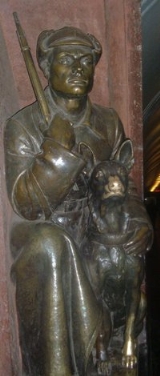
Ploshchad Revolyutsii
Encyclopedia
Ploshchad Revolyutsii is one of the most famous stations of the Moscow Metro
. It is located on the Arbatsko-Pokrovskaya Line
and opened in 1938. The architect was Alexey Dushkin
. The station features red and yellow marble
arch
es resting on low pylons faced with black Armenia
n marble. The spaces between the arches are partially filled by decorative ventilation grilles and ceiling tracery
. Each arch is flanked by a pair of bronze
sculptures by Matvey Manizer
depicting the people of the Soviet Union
, including soldiers, farmers, athletes, writers, aviators, industrial workers, and schoolchildren. There are a total of 72 sculptures in the station.
When the Arbatsko-Pokrovskaya Line was first built, the tracks from Ploshchad Revolyutsii extended westward to Alexandrovsky Sad
rather than Arbatskaya. When the westward extension of the line was completed in 1953, trains were rerouted through the new segment.
and Okhotny Ryad on the Sokolnicheskaya Line
, though the latter can only be reached through Teatralnaya as there is no direct transfer.
Moscow Metro
The Moscow Metro is a rapid transit system serving Moscow and the neighbouring town of Krasnogorsk. Opened in 1935 with one line and 13 stations, it was the first underground railway system in the Soviet Union. As of 2011, the Moscow Metro has 182 stations and its route length is . The system is...
. It is located on the Arbatsko-Pokrovskaya Line
Arbatsko-Pokrovskaya Line
The Arbatsko–Pokrovskaya Line is a line of the Moscow Metro. Chronologically the second to open, now it connects with the district of Mitino and town of Krasnogorsk to the northwest of Moscow with the east of the Russian capital passing through the city centre...
and opened in 1938. The architect was Alexey Dushkin
Alexey Dushkin
Alexey Nikolayevich Dushkin was a Soviet architect, best known for his 1930s designs of Kropotkinskaya and Mayakovskaya stations of Moscow Metro...
. The station features red and yellow marble
Marble
Marble is a metamorphic rock composed of recrystallized carbonate minerals, most commonly calcite or dolomite.Geologists use the term "marble" to refer to metamorphosed limestone; however stonemasons use the term more broadly to encompass unmetamorphosed limestone.Marble is commonly used for...
arch
Arch
An arch is a structure that spans a space and supports a load. Arches appeared as early as the 2nd millennium BC in Mesopotamian brick architecture and their systematic use started with the Ancient Romans who were the first to apply the technique to a wide range of structures.-Technical aspects:The...
es resting on low pylons faced with black Armenia
Armenia
Armenia , officially the Republic of Armenia , is a landlocked mountainous country in the Caucasus region of Eurasia...
n marble. The spaces between the arches are partially filled by decorative ventilation grilles and ceiling tracery
Tracery
In architecture, Tracery is the stonework elements that support the glass in a Gothic window. The term probably derives from the 'tracing floors' on which the complex patterns of late Gothic windows were laid out.-Plate tracery:...
. Each arch is flanked by a pair of bronze
Bronze
Bronze is a metal alloy consisting primarily of copper, usually with tin as the main additive. It is hard and brittle, and it was particularly significant in antiquity, so much so that the Bronze Age was named after the metal...
sculptures by Matvey Manizer
Matvey Manizer
Matvey Genrikhovich Manizer was a prominent Russian sculptor. Manizer created a number of works that became classics of socialist realism.- Life :...
depicting the people of the Soviet Union
Soviet Union
The Soviet Union , officially the Union of Soviet Socialist Republics , was a constitutionally socialist state that existed in Eurasia between 1922 and 1991....
, including soldiers, farmers, athletes, writers, aviators, industrial workers, and schoolchildren. There are a total of 72 sculptures in the station.
When the Arbatsko-Pokrovskaya Line was first built, the tracks from Ploshchad Revolyutsii extended westward to Alexandrovsky Sad
Alexandrovsky Sad
Alexandrovsky Sad:* Alexander Garden* Alexandrovsky Sad * Alexander Garden * Alexander Garden * Alexander Garden * Alexandrovsky Sad * Alexandrovsky Sad...
rather than Arbatskaya. When the westward extension of the line was completed in 1953, trains were rerouted through the new segment.
Transfers
From this station passengers can transfer to Teatralnaya on the Zamoskvoretskaya LineZamoskvoretskaya Line
Zamoskvoretskaya Line , formerly Gorkovsko-Zamoskvoretskaya , is a line of the Moscow Metro. Opened in 1938, chronologically it became the third line. There are twenty stations on the Zamoskvoretskaya line, and it spans , roughly crossing Moscow in a north-south direction. A normal trip along the...
and Okhotny Ryad on the Sokolnicheskaya Line
Sokolnicheskaya Line
The Sokolnicheskaya Line is the first line of the Moscow Metro, dating back to 1935 when the system opened. Presently the line has 19 stations with a total of of track...
, though the latter can only be reached through Teatralnaya as there is no direct transfer.
Trivia
- One of the bronze sculptures — a dog that accompanies a frontier guard — is believed to bring good luck if you rub its nose.
External links
- metro.ru
- mymetro.ru
- KartaMetro.info — Station location and exits on Moscow map (English/Russian)

